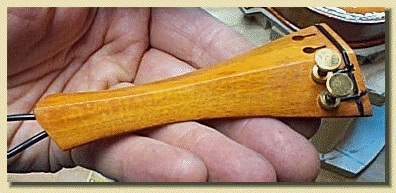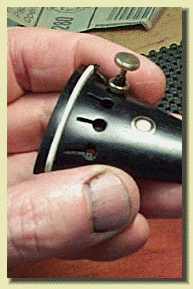(c) Copyright 2022 by David Langsather
Some additional thoughts....
...I believe that all excellent instruments have this special acoustical characteristics:
The tail piece (and its string bar) exactly matches the needs of the instrument.
... I believe that if you tap along the fingerboard top surface under a specific string from nut all the way to the end of the fingerboard on an excellent instrument, you will discover how even the 'tap' tone is { 227 1/2 HZ downward tap tone}. The result of this is that all the notes played on that string will be 'even' in power and sound quality.
... Now if you tap down on the string bar of the tailpiece (the wood cross bar that first touches the string coming from the bridge) for that same string, you will discover that the string bar's 'tap' tones sound in harmony with that of the fingerboard at (191.3 x2) HZ.
...The idea is to even out the fingerboard 'tap' tones first. This is done by carefull re-shaping the fingerboard top and/or side shapes untl the ideal even tap tone is achieved. (please see separate articles). ( 227 1/2) HZ tap tones in downward direction, evenly all over top surface).
{which means that the fingerboard side tap tone is evenly 242 HZ on both sides also.}
...Next the nut is reshaped slightly so as to match the fingerboard's tap tone. This ensures that the open strings match the fingered strings. (same loudness).
...Lastly, but of vital importance to the success of the instrument, the tail piece is selected or changed so that its' tap tone is (227 1/2 x2) HZ {and the string bar of the tailpiece at (191/3 x2) HZ}.
... When the various parts of a fine instrument are tapped, one after the other, they will sound in harmony (even though some of the parts may be at different, but complimentary frequencies).
...Excellent instruments have these acoustical arrangements and your insturment has the potential to be adjusted to have them too.
...I imagine that the special violins used for concert solos and recordings have these characteristics which are foundational to the enjoyment of an instrument both by the player and audience.
... I do not claim that the delicate reshaping necessary is either easy to do or to learn, but it is important to realize that it can be done.
..By tapping downward on the string bar, just next to the string contact, or on top of the string at the string bar contact point; our goal is to make all four of the strings match each other, and at the same time to match the (191.3 x2) HZ tap tone.
.. When different from the (191.3 x2) HZ ideal tap tone, then instrument response time is slower; the farther apart, the slower the response. I imagine that this is an important discovery and a useful adjustment procedure in order to achieve quick instrument response time.
..Now in order to raise the tap tone of a single string ( and not those of the other strings): scrape material evenly from the front either side of the string bar near to that string contact point.
..In order to lower just the tap tone of a single string (and not those of the other strings): scrape, or file, being careful to not touch the delicate string, the top surface of the string bar on either side of the string contact point, near to the string. Do this in tiny steps as a slight amount make a big difference. Listen to the tap tone on both sides and adjust so that the tap tones match and both are at (191.3) HZ on both sides of each string contact point.
..Now to adjust the tap tone of the string bar (to 191.3 x2 HZ), {upon which the four strings rest}:
A
B
GTX081447
A
..The tap tone of each string on the tailpiece is measured by tapping downward directly behind the individual string and along the 'waist' line. Our goal is to make all four string have the same tap tone { 227 1/2 HZ} and that tap tone is our goal vertical tap frequency of (227 1/2) HZ.
Scraping the outside edge here raises the tap tones of both strings on this side of tailpiece.
.The top curved black lines are the cutout areas under the tailpiece.
..The tailpiece is tuned to (227 1/2 HZ). For instruction in tap tone measurement, see www.violinresearch.com.
...So first, let us tackle the adjusting of the tailpiece proper to our selected goal tap frequency.


...The practical use of this principle is: so to adjustment of a certian area of an instrument, compared to an area we will be using at the reference; first tap the reference area (the part we are not going to alter) and immediately after tap the area we want to adjust. Perhaps three light taps on the reference and the a similarly light tap on the area for possible adjustment immediately after. Listen with a 'quiet mind' (no thoughts being 'said' in your mind).
...Now if the second part sounds definitely higher or lower than the reference, then read up on how to adjust the target part to move its tap tone in the right direction (as determined by your listening test).
...Adjust until the second tapped area sounds neither higher or lower than the reference.
...With my approach, the tap tone of the string bar will be (191.3 x2) HZ.
{Actually 382.6 HZ but you can tune from 191.3 HZ)
..See useful tools section of tap tone technology section to learn how to make a wood reference tap tone tool.
..String Bar of the tail piece. It must be tuned separately (after the tailpiece, also to (191.3 x2 HZ) downward tap.
...I beleive that this might be a useful acoustical principle of excellent performing instruments:
If you tap compare various parts of these instruments all the taps will sound in harmony with each other , almost as if they are the same frequency, even though they may be of considerably different tap tone frequencies in reality. If all the parts sound in harmony, then the played instrument will also sound in harmony, with no part fighting the others, with all parts working together to bring forth music in a pleasing manner to listen to.
..This Tap Tone / Wood Tone scale includes 176, 191.3, 198, 213, (232.2),( 227 1/2), 242 HZ.


...The ideal acoustical frequencies for full sized violin are: (227 1/2) HZ for fingerboard, ( 213) HZ for top plate, and (191.3) HZ for bass bar; with (227 1/2 x2) HZ the tap tone of tailpiece proper. (All vertically downward taps). The side tap tone of the tailpiece is {232.3 x2) HZ all around the outside perimeter) (when the top plate, vertical tap tone is 213 HZ.
..Now a furthur complication...The wood block that goes from side to side at the front end of the tailpiece (I call the "String Bar"), on which the strings rest, must be tuned separately from the tailpiece proper. This 'tailpiece string bar' should be acoustically tuned to (191.3 x2) HZ at each string position. Playing an instrument with a mistuned string bar is the main cause of slowness of response of the instrument in playing.
...So, if you encounter an instrument that plays well, but it takes a noticable amount of bow motion to fully form the tone, then the string bar may be at fault. ...Fortunately it is relatively easy to adjust, so that the response becomes as quick as it should be.

... A proper tailpiece-to-fingerboard acoustical match is critical for best performance of your violin, viola, cello or double bass.
... Both volume and tone benefit when the tailpiece acoustically relates to the fingerboard and rest of the instrument. The reason these two must work together involves the vibrating string. One end of the string is attached to the tailpiece and the other is anchored to the fingerboard by the stopping finger (or to the nut next to the peg box, if an open string is being played). When the string vibration reaches the end of the string, it reacts with the supporting structure (and the frequency of the violin at these locations) and is then reflected back down the string again. If the frequencies are not in harmony with each other, at the two ends of the vibrating musical string, it unsettles the vibration pattern which hurts the overall power and tone.
Selecting (or adjusting) the tailpiece of your instrument: (to maximize power and focus of your instrument, and to make response quick.)
(Revised 2/2022)
Page AA_08/14
..The wood area behind the 'A' string is surface scraped to adjust tap tone frequency of the 'A' string. The areas marked A are evenly scraped thinner to lower the tap tone of the 'A' string.
..The area marked B is evenly scraped thinner to raise the A string tap tone.




















